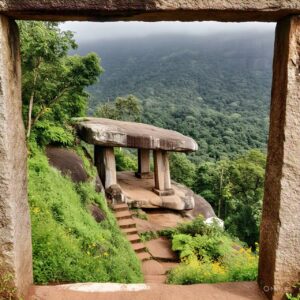
Nestled amidst the lush green hills of Wayanad, Kerala, the Edakkal Caves stand as a monumental testament to India’s prehistoric age and early human civilizations. These caves, often misinterpreted by their name, are not conventional caves but rather a natural rock shelter, created by a massive boulder wedged between two larger stones. With carvings that date back to 6000 B.C., Edakkal Caves are among the oldest sites of human habitation in South India and a key archaeological treasure trove in the Western Ghats.
The Edakkal Caves serve as a living chronicle of the Neolithic and Mesolithic periods, offering deep insights into the life of Stone Age humans. Discovered in 1895 by Fred Fawcett, a British police officer and antiquarian, these caves have since intrigued archaeologists, historians, and tourists alike. The petroglyphs (rock engravings) found within depict human and animal figures, geometric shapes, symbols, tools, and scenes of daily life, which are significant markers of early civilization in the Indian subcontinent.
The diversity of the artwork suggests that Edakkal was inhabited across multiple historical phases. These carvings were believed to be created by various prehistoric tribes and early settlers who used the site for religious, communal, and living purposes. These markings are not only limited to art but also include scripts in ancient languages, indicating early communication systems and possible trade or cultural exchanges.
Unique Features of the Edakkal Caves
There are two main caves at Edakkal, situated at an altitude of approximately 1,200 meters (about 3,900 feet) above sea level. The first cave measures around 96 feet long and 22 feet wide, while the second cave is smaller, at 18 feet long and 12 feet wide. These caves are formed not by erosion or lava flow but by natural fissures in the rock, believed by local legends to be the result of a divine arrow shot by Lord Rama, hence the name ‘Edakkal’—which means “a stone in between” in Malayalam.
The walls of the caves are covered with remarkable petroglyphs, which are both intricate and expansive. These include:
-
Human figures in various postures
-
Animals such as elephants and deer
-
Symbols and geometric shapes
-
Ancient tools and weapons
-
Scripts in Tamil-Brahmi, Sanskrit, and even Indus-like symbols
These discoveries have led scholars to link Edakkal to early Dravidian civilizations, and in some theories, even to the Harappan civilization. The sheer complexity and variety of the carvings reflect the socio-cultural and religious practices of early inhabitants and mark Edakkal as one of the most significant archaeological sites in India.
The Muniyaras and Other Findings
Beyond the caves, the surrounding Ambukuthi Hills have revealed Muniyaras, or ancient burial chambers, which provide further evidence of early settlements. Excavations in these sites have unearthed pottery, tools, and earthenware, many of which are preserved at the Wayanad Heritage Museum. These artifacts collectively help piece together the early human lifestyle, rituals, and technologies used during that period.
Wayanad’s Historical and Cultural Significance
Wayanad, located in the Western Ghats of Kerala, is steeped in history and natural beauty. Known for its verdant forests, spice plantations, and tribal heritage, it has been a cradle of ancient civilization and indigenous culture. The region’s strategic location—connecting the Mysore plateau to the Malabar Coast—made it an important corridor for trade and cultural movement.
The Ambukuthi Hills, where the Edakkal Caves are located, were part of an ancient trade route. This geographical link further reinforces the belief that Edakkal was a thriving prehistoric center for travelers, traders, and settlers from different parts of South India.
How to Reach Edakkal Caves
Reaching Edakkal Caves requires a blend of air, rail, and road travel:
By Air:
-
The nearest airport is Calicut International Airport (Kozhikode), about 90 km from Wayanad.
-
From the airport, visitors can hire a taxi to Kalpetta (the nearest town) and then continue to the caves.
By Train:
-
Wayanad does not have a railway station.
-
The nearest station is Kozhikode (Calicut), well-connected to major cities like Bangalore, Chennai, and Kochi.
-
Taxis and buses are available from Kozhikode to Kalpetta and onward to Edakkal Caves (approx. 26.6 km from Kalpetta).
By Road:
-
Kalpetta is well-connected by bus and road from nearby cities such as Kozhikode (75 km), Mysore (150 km), Bangalore (290 km), and Kochi (250 km).
-
The caves are a short drive and a 1.5 km trek uphill from the parking point.
Best Time to Visit and Tips
-
Visiting Hours: 9:30 AM to 4:30 PM
-
Best Time: November to March (cool and dry season)
-
Entry Tip: Wear comfortable trekking shoes and carry water, sunscreen, and sunglasses. The trek uphill can be moderately challenging but rewarding with panoramic views of the Wayanad valleys.
Why Edakkal Caves Are a Must-Visit
For anyone interested in ancient archaeology, prehistoric art, and India’s cultural heritage, the Edakkal Caves offer an unforgettable experience. They are not just tourist attractions, but also archaeological marvels that narrate the story of human evolution, creativity, and survival. The caves beautifully bridge the past and present, showing us that even thousands of years ago, humans were storytellers, artists, and seekers of meaning.
